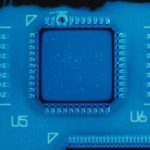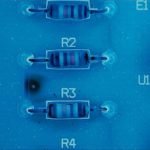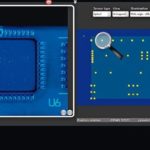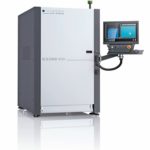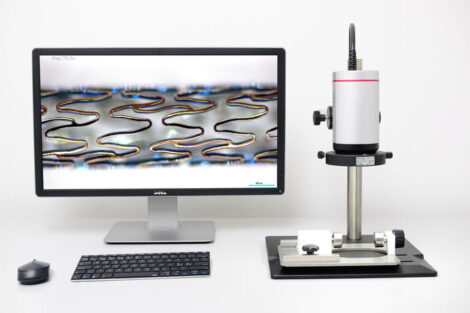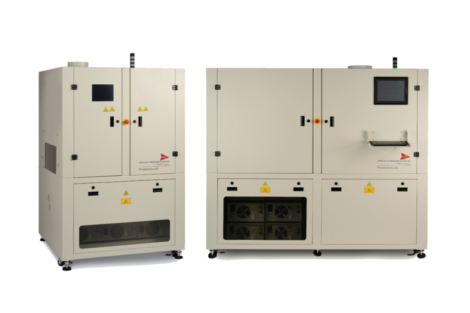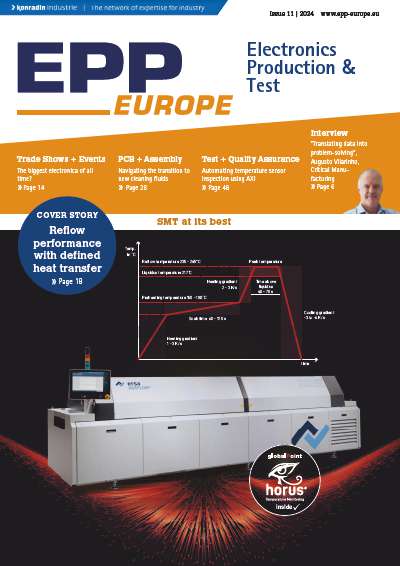There are many different manufacturers that offer a wide range of conformal coatings for various areas of application. In most cases, the coatings are either silicon- or acrylic-based, so different illumination options also need to be taken into consideration during inspection. The coatings are easy to handle, they adhere well, and their viscosity can be easily adapted, making them suitable for use in many different areas. They offer precise handling especially when being applied, and they cure reliably.
There are also chemical hybrids and environmentally-friendly coatings in use which contain no solvents. Demand for these is growing, as they contain fewer volatile organic compounds (VOC). However, these conformal coatings do not provide the same level of adhesion as solvent-based coatings. In series production, conformal coatings are normally applied via dosing systems, making the entire process reproducible. In prototype environment and small lot size production, the coatings can be applied manually.
Protecting safety-relevant electronics is crucial
Conformal coatings are often used when electronic systems need to perform with high levels of reliability. These electronic systems need to be impervious to environmental factors, as they are often responsible for performing safety-relevant tasks. Conformal coatings are used in the military and maritime sector, in aerospace, in industry automation and the automotive industry, which in recent years has contributed tremendously to the continued development of the overall conformal coating process, as well as to the development of new coatings. This development has played a crucial role in electromobility and in semi-autonomous driving. Through these applications, a growing number of electronic systems are finding their way into vehicles, including camera systems and sensors which perform safety-relevant tasks and, in some cases, are already making decisions for human drivers.
For this reason, high levels of reliability are imperative. And they will play a decisive role in future developments in the area of autonomous vehicles and aircraft, as these safety-relevant systems are exposed to wide-ranging, critical environmental factors. Salt spray, extreme temperature changes and chemicals, such as those used in car washes, can cause electronic assemblies to oxidize and become damaged. Protection, and hence proper functioning, can only be achieved by applying conformal coating to assemblies or critical components. The situation is similar in other application areas, such as green energy, where control units in solar parks and wind turbines are exposed to demanding environmental conditions, including salty sea air and extreme changes in humidity and temperature.
Other reasons for the growing use of conformal coatings include progressive miniaturization as well as the increasing component density on electronic assemblies. This development is accompanied by a growth in system functionality. The insulating effect of protective coatings allows the distance between conductor paths to be reduced, thus making higher component densities possible. In addition, the conductor paths are able to carry more electrical power, which leads to better performance in end devices.
Defects and risks of conformal coating
However, all applications of conformal coating have one prerequisite: the assembly surface and the applied protective coating must form a stable, fixed bond, and this bond must hold up against the environmental conditions described above. The growing demands on this process are not entirely unproblematic — the final quality of the conformal coating can be negatively impacted by many material- and process-related variables. These defects have many different causes. A large portion of them can be traced backed to impurities on the assembly, which in turn arise when the circuit board or components are manufactured, or which become attached during assembly production. Material incompatibilities and also quality issues in circuit boards and components, such as poor solder resist curing, flux residues and separating agents on component housings, can play a role in this as well. In most cases this leads to delamination between the assembly surface and the protective coating.
Many other defects can arise frequently and in many different forms. For example, coating can be applied to locations which need to remain uncoated, such as sockets and contacts. Another defect is blistering. Blisters form when air becomes trapped, and in the worst case they can push through to the surface, burst open and leave craters during curing. Moreover, if the coating is applied with excessive pressure, the resulting foam can cause orange peel to form on the coating surface. The thickness of the applied protective coating layer also plays a role — the coating must be applied evenly. Exceeding the layer thicknesses recommended in the manufacturer‘s technical data sheets can lead to delamination and cracks in the coating, or may cause solvent to become trapped, which in turn may cause the formation of blisters. Double-coating as well should only be performed if the material allows for it.
In addition to handling the protective coating in accordance with the manufacturer‘s specifications, the application process needs to be performed without defects and with the right configuration of systems. The assembly to be protected needs to be pretreated. There is a wide range of solutions available for this. Plasma surface treatment not only cleans the assembly, but also activates the surface, allowing a stable bond to be formed between the components. Finally, an automated assembly inspection is the only way to reliably acquire information about the extent to which the conformal coating process was performed without defects. This inspection is essential because it is the only way to ensure compliance with standards and specifications.
Conformal coating inspection: quality criteria
The applied protective coating needs to be inspected in terms of three quality criteria: coating presence, the even and defect-free application of the coating, and layer thickness. The latter can only be determined with a coating thickness spot measurement process, and in practice random sample spot measurements have proven effective for this. For comprehensive inspections of large areas of a circuit board to determine whether the coating is present and has been applied evenly and without defects, the suitable option is automatic optical inspection (AOI), which is called conformal coating inspection (CCI) when used for applied protective coatings. Since the coating is usually transparent and therefore contains few structures, fluorescent dyes must be used, which can be recognized by the AOI system‘s special cameras.
CCI functions and areas of application
CCI systems use UV illumination because coating manufacturers normally add ultraviolet fluorescent particles to their products. These particles can be easily detected by cameras with UV LEDs, thereby making it possible to perform manual and automatic optical inspections on coatings. For this, the particles need to be evenly distributed, and they need to fluoresce uniformly and steadily. If the coating layer has been evenly applied, the properties of the fluorescent particles ensure that light is emitted at a consistent intensity when the particles are exposed to continuous UV light. Camera systems are able to detect and capture the emitted light intensity. Various forms of surface-level damage, such as cracks, blisters, orange peel, excessive coating and even missing coating are made visible by the ultraviolet light. The use of camera systems mounted at angles enables the documentation of these defects and imperfections, as well as of missing protective coating in visible and illuminable gaps, such as the coating on pins and in the spaces between them.
The inspection images captured by the CCI system are automatically analyzed for acceptance or rejection with permitted tolerance values. Detected deviations are classified as defects. Other indicators which can be used for optimizing the conformal coating process are evaluated as well. The protective coating can be inspected both before and after it has cured. With a wet inspection, the coating is inspected before it cures, which makes subsequent reworking and improvements by manufacturing personnel possible.
The S3088 CCI inspection system from Viscom AG offers inspection of transparent protective coatings. With a camera system that features one orthogonal and eight angled cameras, as well as a transport clearance of 105 mm for circuit boards, the S3088 CCI sets itself apart from the other S3088-series systems. It also works with Viscom‘s vVision and Easy Pro inspection software, and hence features the same user interface as the other AOI systems. In standard configuration, the S3088 CCI can perform inline inspections on circuit boards measuring 508 mm x 508 mm. Standard options are available for longer boards. It is important to note that different coating types require different exposure times. For less reflective coatings that contain silicon, the HD option provides a more powerful emission of UV light.
The S3088 CCI‘s integrated UV LEDS provide optimal contrasting between protective coatings and non-coated areas. With a camera resolution of up to 15 μm/pixel, the S3088 CCI makes cracks, blisters, smearing and coating splatter easy to see. The coating can also be inspected for completeness. In addition to dry inspection, the it also offers a wet inspection option. For this option, the customer connects an internal extraction system to the S3088 CCI to ensure that the concentration inside the system remains low. The S3088 CCI also offers a 3D spot measurement option for coating thickness, which uses a vertically installed sensor to spot measure the distance between the coating surface and the circuit board surface as a reference plane. The resulting differences represent the thickness of the coating.
The S3088 CCI can also perform qualifications of electrical insulating compounds on circuit boards based on the IPC-CC-830C standard.
Viscom AG
Carl-Buderus-Str. 9–15
D-30455 Hannover Germany
Tel.: +49 511 94996–0
E-Mail: info@viscom.de
Website: www.viscom.com
Sicher funktionierende Elektronik benötigt eine zuverlässige Inspektion von Schutzlacken. Das vorgestellte Inspektionssystem ist einfach adaptierbar auf die Anforderungen unterschiedlicher Schutzlacke zur präzisen Detektion von Fehlstellen inklusive schneller Prüfprogrammerstellung.
Le bon fonctionnement de l’électronique exige une inspection fiable des vernis de protection. Le système d’inspection présenté est facilement adaptable aux exigences des différents vernis de protection pour une détection précise des points de défaut, y compris la création rapide de programmes d’inspection.
Решение для автоматизированного хранения с контролируемым кондиционированием воздуха и реализация индивидуального интерфейса клиента, включая интеграцию дополнительных мест складирования, соответствовали требованиям бельгийской компании к полупроводниковым датчикам в автомобильной отрасли.
- Figure provided by Electrolube (introduction to the product brochure „Conformal Coatings: Enhanced protection for ultimate PCB performance“). Coating thicknesses up to 300 µm can be found in other sources.
Viscom creates customer care teams to ensure intensive support





